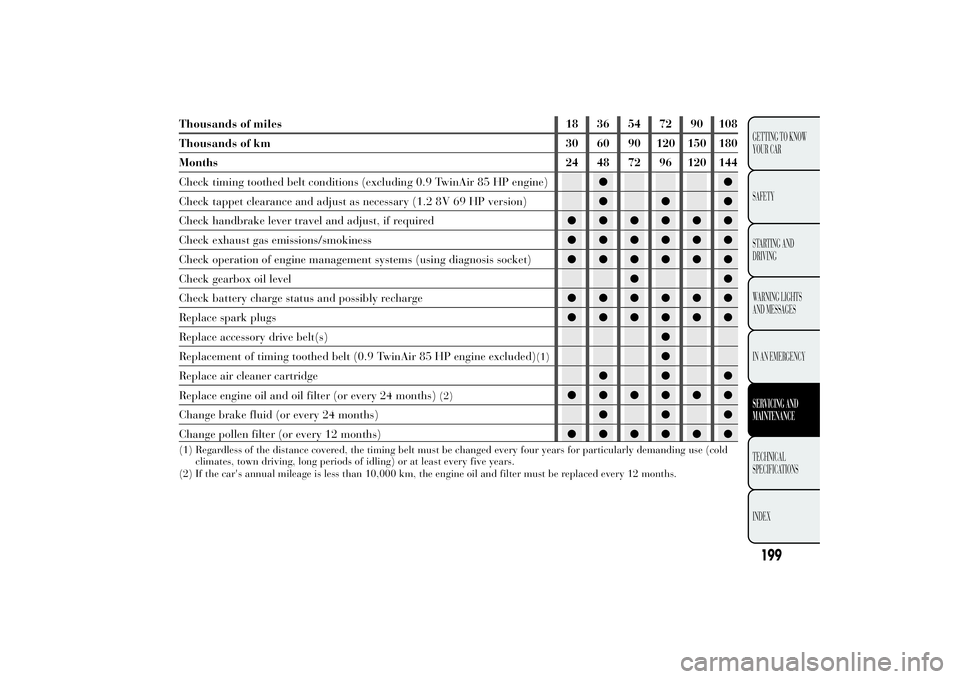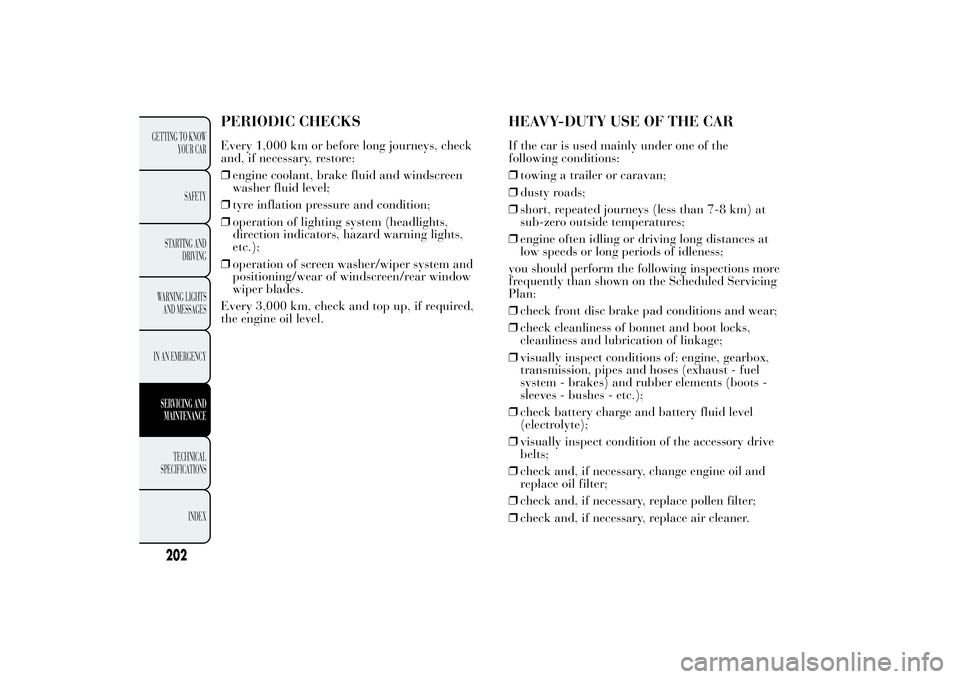tow Lancia Ypsilon 2011 Owner handbook (in English)
[x] Cancel search | Manufacturer: LANCIA, Model Year: 2011, Model line: Ypsilon, Model: Lancia Ypsilon 2011Pages: 299, PDF Size: 13.35 MB
Page 198 of 299

WARNING
The front and rear tow hooks should
be used only
for emergencies on
the road. You are allowed to tow the car for
short distances using an appropriate device
in accordance with the highway code (a rigid
bar), to move the vehicle on the road in
readiness for towing or transporting via a
breakdown vehicle. Tow hooks MUST NOT
be used to tow vehicles off the road or where
there are obstacles and/or for towing
operations using cables or other non-rigid
devices. Respecting the above conditions,
towing must take place with the two vehicles
(one towing, the other towed) aligned as
much as possible along the same centre line.
196
GETTING TO KNOW
YOUR CAR
SAFETY
STARTING AND
DRIVING
WARNING LIGHTS
AND MESSAGESIN AN EMERGENCYSERVICING AND
MAINTENANCE
TECHNICAL
SPECIFICA
TIONS
INDEX
Page 199 of 299

SERVICING AND MAINTENANCE
SCHEDULED SERVICINGCorrect servicing is essential in guaranteeing a
long life for the car under the best conditions.
Lancia has prepared a series of checks and service
operations to be carried out every 30,000
kilometres (for petrol versions) or every 35,000
kilometres (for diesel versions).
Check the items on the Scheduled Servicing Plan
(e.g. periodically check level of liquids, tyre
pressure, etc.) before 30,000/35,000 km and
between these services deadlines.
Scheduled Services are offered by all Lancia
Dealerships according to a set time schedule. If,
during each operation, in addition to the ones
scheduled, the need arises for further
replacements or repairs, these may be carried out
only with the explicit agreement of the Customer.
If your car is used frequently for towing, the
interval between one service operation and the
next should be reduced.WARNING
At 2000 km from the next service operation the
display will show a message.
The Scheduled Services are set out by the
Manufacturer. Failure to have them carried out
may invalidate the warranty.
It is advisable to inform the Lancia Dealership of
any small operating irregularities without waiting
for the next service.
197GETTING TO KNOW
YOUR CAR
SAFETY
STARTING AND
DRIVING
WARNING LIGHTS
AND MESSAGES
IN AN EMERGENCYSERVICING AND
MAINTENANCETECHNICAL
SPECIFICA
TIONS
INDEX
Page 201 of 299

Thousands of miles 18 36 54 72 90 108
Thousands of km 30 60 90 120 150 180
Months 24 48 72 96 120 144
Check timing toothed belt conditions (excluding 0.9 TwinAir 85 HP engine)●●
Check tappet clearance and adjust as necessary (1.2 8V 69 HP version)●●●
Check handbrake lever travel and adjust, if required●●●●●●
Check exhaust gas emissions/smokiness●●●●●●
Check operation of engine management systems (using diagnosis socket)●●●●●●
Check gearbox oil level●●
Check battery charge status and possibly recharge●●●●●●
Replace spark plugs●●●●●●
Replace accessory drive belt(s)●
Replacement of timing toothed belt (0.9 TwinAir 85 HP engine excluded)
(1)
●
Replace air cleaner cartridge●●●
Replace engine oil and oil filter (or every 24 months)
(2)
●●●●●●
Change brake fluid (or every 24 months)●●●
Change pollen filter (or every 12 months)●●●●●●
(1) Regardless of the distance covered, the timing belt must be changed every four years for particularly demanding use (cold
climates, town driving, long periods of idling) or at least every five years.
(2) If the car's annual mileage is less than 10,000 km, the engine oil and filter must be replaced every 12 months.
199GETTING TO KNOW
YOUR CAR
SAFETY
STARTING AND
DRIVING
WARNING LIGHTS
AND MESSAGES
IN AN EMERGENCYSERVICING AND
MAINTENANCETECHNICAL
SPECIFICA
TIONS
INDEX
Page 204 of 299

PERIODIC CHECKSEvery 1,000 km or before long journeys, check
and, if necessary, restore:
❒engine coolant, brake fluid and windscreen
washer fluid level;
❒tyre inflation pressure and condition;
❒operation of lighting system (headlights,
direction indicators, hazard warning lights,
etc.);
❒operation of screen washer/wiper system and
positioning/wear of windscreen/rear window
wiper blades.
Every 3,000 km, check and top up, if required,
the engine oil level.
HEAVY-DUTY USE OF THE CARIf the car is used mainly under one of the
following conditions:
❒towing a trailer or caravan;
❒dusty roads;
❒short, repeated journeys (less than 7-8 km) at
sub-zero outside temperatures;
❒engine often idling or driving long distances at
low speeds or long periods of idleness;
you should perform the following inspections more
frequently than shown on the Scheduled Servicing
Plan:
❒check front disc brake pad conditions and wear;
❒check cleanliness of bonnet and boot locks,
cleanliness and lubrication of linkage;
❒visually inspect conditions of: engine, gearbox,
transmission, pipes and hoses (exhaust - fuel
system - brakes) and rubber elements (boots -
sleeves - bushes - etc.);
❒check battery charge and battery fluid level
(electrolyte);
❒visually inspect condition of the accessory drive
belts;
❒check and, if necessary, change engine oil and
replace oil filter;
❒check and, if necessary, replace pollen filter;
❒check and, if necessary, replace air cleaner.
202
GETTING TO KNOW
YOUR CAR
SAFETY
STARTING AND
DRIVING
WARNING LIGHTS
AND MESSAGES
IN AN EMERGENCYSERVICING AND
MAINTENANCE
TECHNICAL
SPECIFICA
TIONS
INDEX
Page 237 of 299

WEIGHTS AND LOADSVersions 0.9 TwinAir 85 HP 1.2 8V 69 HP 1.3 16V MultiJet
Unladen weight (with all fluids, fuel
tank filled to 90% and without
optional equipment) (kg):975 965 1050
Payload including the driver (kg):(*)
480 (4-seater) / 535
(5-seater)480 (4-seater) / 535
(5-seater)480 (4-seater) / 535
(5-seater)
Maximum permitted loads (kg)
(**)
800 870 – front axle:
– rear axle: 810 810 810
– total:1455 (4-seater) / 1510
(5-seater)1445 (4-seater) / 1500
(5-seater)1530 (4-seater) / 1585
(5-seater)
Towable loads (kg)
750 750 – braked trailer:
– non-braked trailer: 400 400 400
Maximum load on roof: 55 55 55
Maximum load on the tow hook
(braked trailer) (kg):60 60 60
(*) If special equipment is fitted (sunroof, tow hitch, etc.) the unladen car weight increases, thus reducing the specified payload
with respect to the maximum permitted load.
(**) Loads not to be exceeded. The user is responsible for arranging goods in the luggage compartment and/or load carrying
platform within the maximum permitted loads.
235GETTING TO KNOW
YOUR CAR
SAFETY
STARTING AND
DRIVING
WARNING LIGHTS
AND MESSAGES
IN AN EMERGENCY
SERVICING AND
MAINTENANCETECHNICAL
SPECIFICA
TIONSINDEX
780
1000
Page 265 of 299

INTRODUCTIONThe radio has been designed according to the
passenger compartment's specific characteristics
and with a personalised design that complements
the style of the dashboard.
The instructions for use are given below. We
recommend that you read them carefully.
TIPS
Road safety
Familiarise yourself with the various car radio
functions (e.g. storing radio stations), before
starting to drive.
Reception conditions
Reception conditions change constantly while
driving. Reception may be interfered with by the
presence of mountains, buildings or bridges, or
when you are far away from the broadcaster.
Note
The volume may be increased when receiving
traffic alerts and news.
WARNING
If the volume is too loud this could be
dangerous for the
driver and for
passengers when driving in traffic. Always
adjust the volume so that you can still hear
background noises.
Maintenance and care
Only clean the cover with a soft, anti-static cloth.
Cleaning and polishing products may damage the
surface.
CD
Dirt, scratches or any distortions on CDs may
cause skipping during playback and poor sound
quality. Follow these tips for optimum playback
conditions:
❒only use CDs with the brand:
❒clean every CD thoroughly removing any
fingerprints or dust using a soft cloth. Hold CDs
by the circumference and clean them from the
centre towards the edge;
263
SOUND-SYSTEM
Page 297 of 299

Setup for "Isofix" child
seat ................................... 122
Side air diffusers .................. 35
Side Bag ............................. 127
Side lights/brake lights ....... 176
Side lights/day lights
(DRL)
– bulb replacement............ 172
Snow chains........................ 140
Sound system (wiring) ......... 90
Spark plugs (type) .............. 223
Speedometer ........................ 8
Speedometer (speed
indicator) ........................... 7
Starting the engine ...... 132-156
Starting up and driving....... 132
Start&Stop system ............... 83
Start&Stop (system)............. 83
Steering .............................. 226
Steering lock ........................ 28
Steering Wheel ..................... 32
Steering wheel stalks
– left stalk .......................... 47
Storing the car .................... 141
Sun roof ............................... 64
Sun visors ............................ 62Suspension.......................... 226
Technical data.................... 220
Third brake light ................ 176
Top speed ........................... 234
Towing the car .................... 194
Towing trailers .................... 138
Transmission ...................... 224
TRIP button ......................... 21
Trip Computer
– TRIP button .................... 21
– Trip Computer ................. 19
– Trip Computer
parameters ...................... 20
Ty r e s
– correct tyre reading ........ 227
– Fix&Go Automatic (kit) . 163
– inflation pressures .......... 231
– Rim Protector tyres ........ 232
– snow tyres ...................... 228
– tyres provided ................ 228
Tyres - maintenance............ 211"Universal" child seat
fitting................................ 124
Universal Isofix (child
seat).................................. 122
Using the gearbox ............... 135W
arning lights on panel ..... 142
Weights and loads ............... 235
Welcome movement ............. 11
Wheel rims
– correct reading of the
wheel rim ....................... 228
– dimensions ..................... 228
– rim protector .................. 232
– rims and tyres ................ 227
– wheels and tyres ............. 211
Wheels and tyres
– changing a wheel ............ 157
– Fix&Go Automatic (kit) . 163
– spare wheel .................... 227
– tyre inflation pressure..... 231
– Wheels and tyres ............ 211
Window bag........................ 128
Window cleaning .................. 50
Windows (cleaning) ............ 217
295GETTING TO
KNOW YOUR CAR
SAFETY
STARTING AND
DRIVING
WARNING LIGHTS
AND MESSAGES
IN AN EMERGENCY
SERVICING AND
MAINTENANCE
TECHNICAL
SPECIFICATIONSINDEX